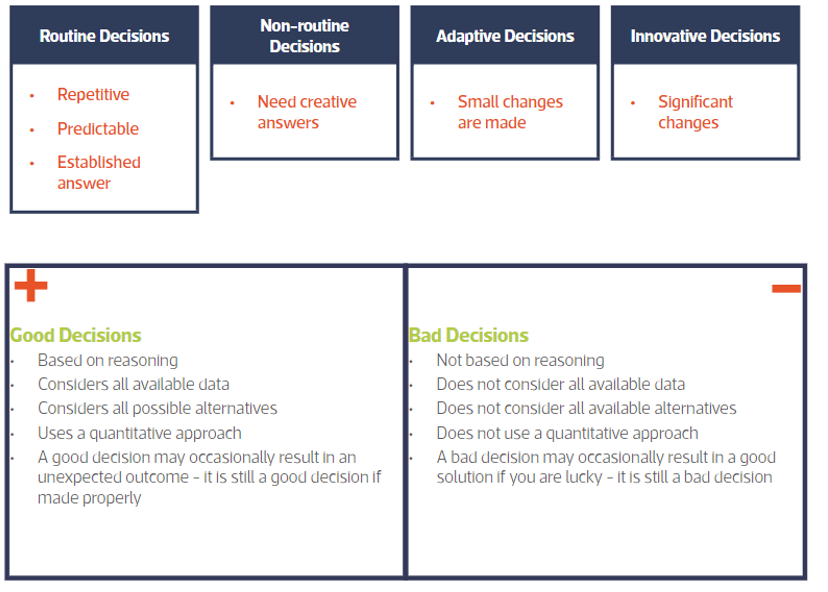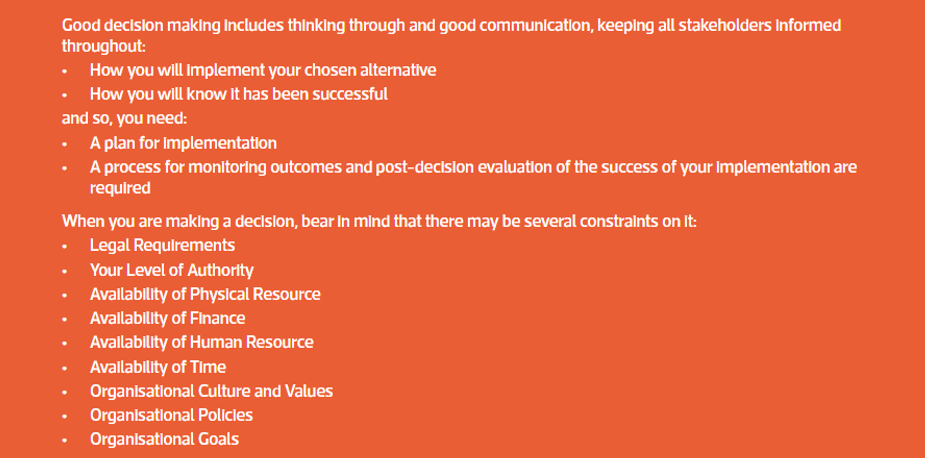"The process of making decisions is about selecting the best choice from all the available alternatives." (Brockman, 2016)
You need to make a decision in any situation where you are faced with alternative options. In fact, you already make decisions every day, for example:
- What time should you leave home to be at work on time?
- How should you respond to a particular customer or colleague request?
- Which learning activity should you choose?
What are the different types of decisions?
Decisions can be classified into several different categories:

Most decisions can be broken down to three main stages:
1. Understanding the Purpose:
First of all, you need to gain agreement and clarity about why a decision needs to be made, you need to know what the decision is trying to achieve and also what it is not. In this way you can build up an initial picture of what the implications of the decision are likely to be.
Ask questions like: What is wanted? Why is it wanted? When is it wanted? How is it wanted? How much is wanted? Who should be involved?
This will help you to understand the scope of your decision. When collecting information, it is important that you keep asking yourself questions, and avoid false assumptions. You want valid information to base your decision on.
Valid information is accurate and relevant for the decision you are making.
A collection of raw facts and figures are called data and do not usually mean very much until they have been analysed in some way and become meaningful. This is when data is called information. Data is of two main types:
- Quantitative Data which can be counted; it is numerical.
- Qualitative Data which is not numerical; it is descriptive, for example, people’s opinions.
At the end of this stage you should know why you are making the decision and what you are hoping to achieve (the objective).
2. Evaluating alternatives
There are usually a number of alternative decisions to choose from and it is important to keep open to all possible choices seeking advice from others to avoid unconscious bias. Decision making criteria can be established - these are objective statements that need to be met for a decision to be the best it can be in the circumstances (success criteria).
Another process is to make a pros and cons list (advantages and disadvantages or for and against) for each option.
These can be weighted as 1 (minor significance) to 5 (extremely significant), and the total scores of the two columns compared. This gives an indication of the overall attractiveness or benefit of each option.
|
Example: Weighing up the pros and cons |
|
|
Should I work from home? |
|
|
Pros |
Cons |
|
No daily commute to work (5) |
Less face-to-face time with colleagues (3) |
|
Savings on expenses (4) |
Home office costs (3) |
|
More work flexibility (4) |
Increased isolation (4) |
|
No office distractions (3) |
Risk of burnout (4) |
|
Total pros score 16 |
Total cons score 14 |
Count the weightings, not the number of pros and cons, and if the pro total exceeds your cons total, you should go ahead with your decision. In the above example, your decision is to work from home.
3. Making a Choice
Your decision needs to be effective (it must achieve the goal permanently, or for a reasonable period of time), efficient (it must achieve the goal without causing other issues or problems) and viable (it must take account of various constraints that apply) so that you can be sure it will be a good decision in practice. In times of pressure, the leader may use both logic and intuition.
Tools and Techniques
There are many different tools and techniques that can help you to make good decisions, such as decision matrices, decision trees, SWOT and PESTLE analysis, and Cost-Benefit Analysis (CBA), a decision-making tool that calculates the potential costs of taking a particular decision and compares those costs against the potential benefits of that decision. It is important to choose the tool or technique that is most appropriate for your situation.
Implementation and Evaluation
Your decision making is not complete until you have implemented and evaluated your chosen alternative.
- Implementation is the process of putting your choice into practice.
- Evaluation is the process of judging how successful it has been.

References
Brockman, J. (2016). Thinking: The New Science of Decision-Making, Problem-Solving, and Prediction Publ. HarperCollins, N.Y, USA
Are you a good decision-maker? Test yourself with our Scorecard.
If you’re a member, you can test yourself on Decision Making and see if you meet the standard.
Spotlights
Further Resources
From the blog







